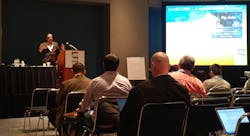The Future of Smart Cities Relies on Artificial Intelligence
Amid rampant confusion about what artificial intelligence (AI) really means, the gradual implementation of Internet of Things (IoT) technologies in city infrastructure and services is setting the stage for practical applications of AI with the potential to enhance city services and alleviate some of the problems cities confront. In a talk at Lightfair Wednesday, Sohrab Modi, senior vice president and chief technology officer of Echelon, told attendees about practical applications of AI technology in a “smart city” setting.
Modi, whose background includes managing technical teams involved in launching early cloud computing services and machine-to-machine and IoT development at the executive level for companies including Sun Microsystems, Huawei, N1 Systems and Novell, said the value of AI comes when it moves from reporting what happened in the past to predicting what will happen in the future.
He characterized today’s development work in artificial intelligence as an “AI storm” generated by a combination of emphasis on machine learning, a shift in emphasis away from making a computer think like a human and toward using AI to solve practical real-world problems, and the growth of enormous databases commonly referred to as Big Data. “Big data sets and the relations between them as they change at different speeds is crucial to AI,” he said.
Modi said lighting control systems provide an excellent platform for smart city development because lighting is pervasive. As a platform for devices a lighting system can feed artificial intelligence the data it needs to improve to smart city systems ranging from government, health, asset management, traffic management, safety and security, facilities and buildings management and sustainability management.
This symbiotic relation between the IoT and AI can lead to practical solutions to city problems but making that a reality involves several challenges in the areas of privacy, security, accuracy and bandwidth, Modi said. Further development of edge-computing techniques where data is crunched at the device level and only the results are transmitted to the central system for further processing will help to address the costs of maintaining the bandwidth the systems demand. But that presents another challenge particularly relevant to the attendees at Lightfair.
“The people who create the devices and the people who create AI don’t look at each other, much less talk to one another,” he said. “There is a risk of creating islands by focusing on one application to the exclusion of others.”
